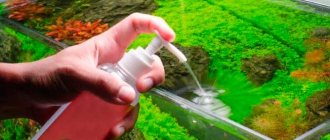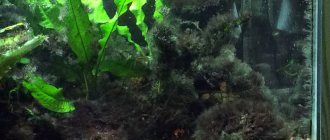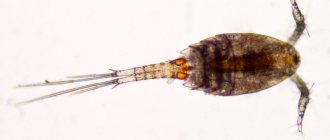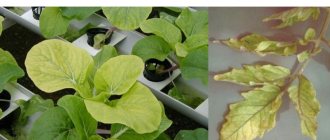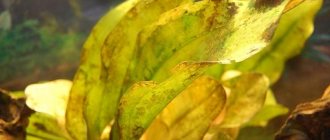Causes of diseases:
- Lack or excess of lighting. With a lack of light, growth stops, the color fades, the stem becomes thinner, and the lower leaves die off. If there is an excess, the tops become very elongated and the leaves become small.
- Inappropriate temperature conditions. For aquaflora, as well as for fish, temperature plays a big role. At low temperatures the plant may freeze. The higher the water temperature, the faster metabolic processes occur and the more the green flora needs light and fertilizing.
- Incorrectly selected soil can cause blackening and disease of the roots. Maximum ecosystem health can be achieved by completely replacing the soil or adding nutritional supplements.
- Insufficient filtration.
- Inappropriate chemical composition.
- Imbalance of micro-, macroelements.
- Other inhabitants of the aquarium (snails, aphids, parasitic algae, etc.).
Effect of light and temperature
In low light, plants become pale in color and lose their lower leaves. They try to get closer to the light, their internodes stretch out, their stems become thinner, and they shed their leaves at the bottom. In this case, you need to see if other plants in the aquarium are taking up too much light, and thin them out if necessary. You can also make the lighting more powerful.
If your plants have unusually small leaves, it means they are not getting enough light and need feeding. If the red part of the spectrum of the lighting lamp is too powerful, the upper parts of the leaves may become elongated.
Don't forget that the higher the temperature in the aquarium, the more lighting it needs. If the ratio of light and water temperature is disturbed, plants develop long internodes and small leaves.
Water temperature plays a huge role. Just like fish, when the temperature drops, the plant can “freeze” and die. At elevated temperatures, all processes in the plant body are accelerated and require an influx of significantly greater amounts of nutrients, including carbon dioxide, which, in turn, increases the need for brightness of lighting for the processes of photosynthesis.
Video
DISEASES OF AQUARIUM PLANTS AND THEIR CAUSES
DISEASES OF AQUARIUM PLANTS. CAUSES AND METHODS OF ELIMINATION
Why do plants in an aquarium rot and become sick?
Diseases of aquarium plants #webcam#aquarium
All about plant diseases and how to identify them.
ZOO-portal EXOTICS
Add a comment
Lack of iron and calcium
Many plants in aquarium conditions require fertilizing with fertilizers. Due to a lack of nutrients in the soil, they can wither and wither. Holes appear on the leaves, the edges lose their even shape, and the color becomes pale.
But we must not forget about the soil. It is undesirable for the soil to be too dense. Because of this, plants' leaves and roots may become deformed. This is especially true for young plants. The quantity and quality of soil must meet the requirements of individual plant species.
Iron. If there is not enough iron in the water, the plant turns yellow, “glasses” and may die. To avoid this, just put a few orange or red pebbles, which contain a lot of iron, on the bottom. Adding about 0.1-0.2 mg of iron sulfate per 1 liter of water to the aquarium weekly significantly increases the brightness of the greenery of most plants, especially improving the red color of young leaves and shoots. If, on the contrary, there is more iron in the water than needed, the plant will turn yellow, but the veins of the leaves will remain green. To destroy excess iron, dissolve a little manganese in water.
Calcium. When there is a lack of calcium in plants, the edges of the leaves turn yellow. To eliminate this, an empty shell (necessarily disinfected) is placed in the aquarium. Once balance is restored, the sink can be removed.
Diseases and their treatment
To determine what exactly the plants need, you need to carefully examine them. If growth simply stops, but the leaves do not lose their color or fall off, then it may simply require new soil. This mainly happens 2 years after its replacement.
Diseases associated with lighting and water temperature
Signs of lack of lighting:
- pale color;
- loss of lower leaves;
- thin stems, as plants try to stretch towards the light;
- elongated internodes;
- small leaves.
Treatment:
- increase lighting;
- If necessary, thin out the diseased species and other plants if they block the access to light;
- feed if the leaves begin to shrink.
An excess of light causes the upper parts of the leaves to elongate. In this case, reduce the power of the lamps.
The temperature of the water plays an important role; its sharp decrease leads to the death of the flora, it simply freezes. Increased water temperature accelerates synthesis processes. And this, in turn, requires the supply of a significant amount of carbon dioxide and, consequently, an increase in lighting power. There is a rule: the higher the water temperature, the more powerful the lighting.
Diseases associated with nutritional deficiencies
With a lack of nitrogen, growth slows down, the leaves become brownish-yellow with yellow veins. This disease is called nitrogen starvation. The temperature should be reduced and 10 mg of nitrogen per 1 liter should be added 4 times a month.
A lack of phosphorus can be detected with severe darkening and curling of young leaves and shoots. The brown spots that appear on the leaves gradually turn into holes. The norm for adding the element is 10 mg per 1 liter, 4 times a month.
A lack of potassium can be observed on leaves with signs of chlorosis. Adding 10 mg of potassium per liter to water will help cope with potassium deficiency.
If light spots appear on the leaves, but the leaves do not die, then most likely this is a lack of magnesium. Add 5 mg of the element per liter. Depending on the severity of the disease, the procedure is repeated 2 to 4 times a month.
With boron deficiency, chlorosis of young leaves from the edges and base, blackening of the apical growth points is observed. Treat by adding 0.1 mg/1 l, 2-3 times a month.
A sign of manganese deficiency is the appearance of small light and brown spots on the leaves. Treat with the addition of manganese with the same dosage and regularity as for boron deficiency.
Signs of calcium deficiency are twisted, yellowed leaves with curled edges, as well as blackening of the growing points. The deficiency is compensated in a proportion of 10 mg/liter.
Pale green or yellow leaf color with white areas between the veins occurs in plants with iron deficiency. With this diagnosis, it is recommended to add 0.1 mg of the substance per liter of water 2-3 times a month.
A lack of copper in water is characterized by blanching of the entire leaf blade, and the plant begins to bush. Add 0.05 mg of copper per liter to water 3 times a month.
Carbon dioxide deficiency is observed in plants whose leaves have a limescale deposit. This may be due to an incorrect ratio of fish to plants. You can get out of this situation by adding a few more fish or adding regular sparkling water.
Algae diseases
Primitive organisms are present in every aquarium. Algae are not parasites for flora, they are its competitors, interfering with growth. In this case, the algae is seen as a threat to the life of the plant.
Protococcus
Very small spherical plants that, as they grow, form a slimy growth that is bright green on aquarium glass and rocks. They are removed with a kitchen sponge.
Siphon algae (Siphonales)
They usually appear in the brightest areas of the aquarium, on the sunny side, and are a dense layer of thread-like leaves of a dark green color. They can also be removed with a kitchen sponge.
Ulotrix
The balls, consisting of the finest threads, are slimy to the touch and have a light green color. Remove by wrapping them on a match or any rough surface. They are characterized by a short period of rapid development, after which their growth slows down significantly, and then they completely disappear from the aquarium.
Cladophora
This type of algae usually grows on hard surfaces (plant leaves, rocks and driftwood). During the growth process, Cladophora forms branching bushes from greenish to gray in color, about 2-3 cm in size. They are plucked out with tweezers.
Microscopic algae
There is a wide variety of microscopic that are suspended in the water and give aquarium water a greenish, yellow-green or brown color. Method of destruction: complete darkening of the aquarium for several days . Possible methods of combating these algae are also live daphnia, which must be released in large numbers into the aquarium, or snails that eat the algae.
Conjugates, or conjugates (Conjugateae)
They look like green ones. Their most famous representative is filamentous algae (Spirogyra) , which, with its very long and thin threads, entangles all aquarium plants like a web. This usually occurs in very bright lighting. They fight by wrapping them around a stick and tearing them off. Sometimes it happens that these algae suddenly disappear on their own for no reason.
Blue-green algae (Cyanophyta)
They are capable of covering all plants, stones, soil and glass with a very slimy and bad-smelling coating in a short time. They usually develop in strong light and in the presence of nitrogenous compounds in the water, which are caused by dirty water and soil. As a control measure, it is necessary to siphon the soil and replace at least 1/3 of the aquarium water with fresh water with similar parameters.
Chemical methods of combating blue-green algae: - Penicillin at a concentration of 10,000 units. per 1 liter of water, and after two days 2,500 units. for 1 liter of water; — A solution of 3% boric acid in a proportion of 30 ml per 100 l of water; — Streptomycin crushed and dissolved in water in a proportion of 3 mg per 1 liter of water; — Multiple changes of the full volume of aquarium water (the fish are first removed); — The aquarium is darkened and every evening, for 3 days, a solution of bicillin-5 is diluted in water in a proportion of 10,000 units. for 1 liter of water.
After these activities, over the next week, replace 1/3 of the aquarium water every 2 days.
Diatoms (Diatomeae)
They usually appear in low light and are a brown coating that forms on the leaves of plants, the walls of the aquarium and the soil. To combat these algae, it is necessary to increase the lighting intensity.
Red algae, or purple algae (Rhodophyceae)
They are characterized by accelerated development and the ability to grow over the entire area of the aquarium in a short period of time. In order to distinguish green algae from red algae, you need to place them in alcohol or acetone. Green algae will be completely discolored, while red algae will retain their color.
Vietnamese (Audocinella)
Small tassels made of dark green, almost black threads, 1.5-2 cm long, which are tightly attached to the leaves of plants, occupying more and more of its area. To combat the Vietnamese, the following actions can be taken: - supplying CO2, from which the Vietnamese dies; - use of water with a hardness dH of 8° and above, with daily siphoning of the soil and replacing ¼ of the water with fresh water with similar parameters.
Lack of nitrogen, carbon dioxide and sulfur
Nitrogen. Signs of nitrogen starvation: premature death of old leaves, yellowing of the edges and tips of leaves, gradually spreading to the entire leaf blade, slowing of growth.
In this case, you need to gradually lower the water temperature by several degrees. This is due to the fact that the amount of nitrogen in water increases with decreasing temperature. But don't overdo it and don't overcool your fish or other plants!
Carbon dioxide. The leaves of the plants are covered with lime. This means that there are too few inhabitants in the aquarium to ensure the overall balance of carbon dioxide, and it is worth purchasing a few more specimens.
Sulfur. With a lack of sulfur, young leaves change their color to yellow or reddish. The plant can be helped by planting it separately and dissolving 1-2 grains of purified sulfur in water (you can buy it at the pharmacy).
Prevention
In order to prevent plant diseases, it is necessary to create conditions in the aquarium that are suitable for the species contained in it. It is important to observe the required temperature conditions, as well as monitor the chemical composition of the water. It should be remembered that daylight hours that are too long provoke the proliferation of algae, while daylight hours that are too short inhibit the growth of higher representatives of aquatic flora. Herbal aquariums require an additional supply of carbon dioxide and regular fertilization. It is important to ensure good filtration; At night, aeration should be turned on. To protect plants from algae, you can add algae eaters to the aquarium: fish, snails, and shrimp.
Lack of phosphorus and potassium
Phosphorus. Signs of phosphorus starvation are darkening of the color of young leaves, curling of leaves and shoots, and the appearance of brown and reddish-brown spots on old leaves.
Calcium, potassium and magnesium salts of orthophosphoric acid are most often used as phosphorus fertilizers.
When signs of a lack of minerals appear, complex fertilizers, which contain phosphorus, are also added to the water.
Potassium. Potassium deficiency is usually expressed in the appearance of brown and yellow spots on the edges of leaves. You can use complex mineral fertilizer nitrophoska. It contains the most essential macroelements - nitrogen, phosphorus, potassium - in an optimal ratio for plants.
This mineral fertilizer can be added to the aquarium at every water change. The usual dosage is from 1 to 2 g per 100 liters of water.
Signs of Deficiency or Excess of Nutrient Ingredients
Signs of deficiency or excess of nutritional ingredients can be easily identified. Most green plants found in an aquarium urgently require feeding. A deficiency in the amount of nutrients in the soil leads to their lifelessness. Holes appear on the sheets, the edges become uneven, and the color fades.
Macronutrient deficiency
Calcium
Calcium affects the proper development of aquaflora. When plants lack it, the edges of the leaves turn yellow. To eliminate this symptom, a disinfected hollow shell is placed in the aquarium, which is removed after correcting the balance.
Phosphorus
Phosphorus is also necessary to prevent aquarium plants from getting sick. Phosphorus starvation is different in that the shades of fresh leaves become darker, they curl, and old foliage turns brown and becomes covered with reddish spots. In case of phosphorus deficiency, orthophosphoric acid salts based on calcium, potassium, and magnesium are usually used. If there are not enough minerals, complex mineral fertilizers containing phosphorus are added to the water.
Iron
Iron is required to protect aquaflora from diseases. If there is a deficiency of it in water, the vegetation becomes yellow in color and resembles glass in structure, which can lead to death. You can protect the flora by placing 3-4 orange or red pebbles containing this element on the bottom. The problem is also solved by weekly addition of iron sulfate crumbs to the vessel, which increase the intensity of the color, mainly of young plants. An increase in iron content, on the other hand, causes the leaves to yellow, leaving green veins. You can get rid of excess iron by dissolving manganese in water.
Lack of potassium in lemongrass
Nitrogen
Nitrogen contributes to the full life support of plants. Its lack leads to the premature loss of obsolete foliage, yellowing of the edges, which is transmitted gradually to the entire leaf, as well as its slow growth. To eliminate the problem, you should gradually reduce the heat of the water, this will increase the availability of nitrogen. It is important not to overdo it - not to cool the fish.
Sulfur
A lack of sulfur leads to a change in the color of young plants whose leaves turn yellow. The situation can be corrected by transplanting vegetation into a separate container and dissolving a grain of sulfur purchased at a pharmacy in water.
Carbon dioxide
Carbon dioxide protects the flora from the lime that envelops the leaves. This is the result of a lack of “tenants” in the reservoir, which does not allow the general equilibrium to be maintained. It is advisable to acquire several individuals.
Potassium
Potassium is also a necessary ingredient for the natural development of aquaflora. Its deficiency is detected when brown and yellowish marks appear on the edges of the foliage. To correct the situation, it is necessary to apply nitrophoska fertilizer containing the necessary elements in optimal proportions. It is advisable to add it to the aquarium every time the water is changed.
Micronutrient deficiency
Omitting micronutrient content is also a serious mistake, but one that can be easily corrected. They are required by the flora in a minimal amount. A signal of a lack of microelements is considered to be blackness and death of the tops of the stems. Micronutrient deficiency explains why leaves turn black. The excess can be easily eliminated by replacing the water, and the deficiency can be eliminated by adding a complex fertilizer that includes these elements.
Zinc , which aquaflora lacks, is replenished with the addition of zinc sulfate. The copper missing in the water, which leads to the pallor of the entire leaf blade and the loss of the entire leaf, is supplemented in the form of copper sulfate.
The missing boron is replenished by adding boric acid to the water.
Manganese affects the appearance of small brownish spots on the leaves between the veins. Replacement of the element occurs as a result of the addition of potassium permanganate.
An ingredient that affects metabolic processes in aquaflora is molybdenum , the main task of which is considered to be the fixation of nitrogen in plant cells, the regulation of phosphorus nutrition and carbohydrate metabolism.
Cobalt , which enters the aquarium with fish food, sufficiently saturates the flora's need for it. Bloodworms contain the most of this substance. Usually there is no shortage of it.
Most of the macro and microelements are part of the mineral complex. Feeding them should be done systematically, mainly at the time of water change.
Lack of microelements
Microelements. These are boron, zinc, copper, manganese, molybdenum, cobalt.
Signs of boron deficiency are blackening and death of the apical growing points. The lack of boron in aquarium water can be compensated by adding boric acid or borax (0.2 mg per 1 liter of aquarium volume).
The lack of zinc can be compensated by adding zinc sulfate, which is added in an amount of 0.1 mg per 1 liter of water.
If there is a lack of copper in the water of the aquarium, the entire leaf blade turns pale, and the soft tissues of the leaf die. Copper can be added to the aquarium in the form of copper sulfate (0.2 mg per 1 liter of water).
Manganese deficiency manifests itself in the appearance of small, first light, and then brown spots between the veins of young leaves.
Most macro- and microelements are contained in complex mineral fertilizers. It is necessary to fertilize with mineral fertilizers periodically. This is best done with regular water changes once a week or every ten days. Fertilizers are added to the water being changed, the volume of which is usually 1/5-1/4 of the volume of the aquarium.
Dark veins on lightened leaves of a plant
Dark veins on lightened leaves of the plant (interveinal chlorosis) indicate a lack of magnesium. This can happen in soft water, or improperly prepared osmosis. To eliminate magnesium deficiency and proper water treatment, use H2O + remineralizer
H2O+remineralizer: Reductant for osmotic, deionized, distilled or slightly mineralized water. Designed for aquariums with aquatic plants. Contains all the basic substances necessary to prepare ideal water parameters for maintaining capricious species of aquatic vegetation. Instructions for use: To increase hardness by 3.5 degrees Gh - 1 level tablespoon (16 grams) per 100 liters of water. Pre-stir the sample in a liter of water and pour it into the water being changed. We recommend keeping the hardness at 5-6 degrees Gh. To do this, you need 2.3 grams per 10 liters of water being changed (if you don’t have a scale, cut off a heap from a teaspoon with a knife). In fact, the packaging is enough to change +/- 1500 liters of water.
Magnesium (Mg) is an essential element of the plant nutrition program and serves as a structural component of plant tissue, being the central atom of the chlorophyll molecule. It is necessary for the rapid occurrence of growth processes, cell division, maintaining protein levels, building pectin substances in cell walls, and also affects the absorption of phosphorus. With a lack of magnesium, interveinal chlorosis occurs, necrosis of the lower old leaves. Excess magnesium can reduce the absorption of calcium, potassium and manganese.
Diseases associated with algae
Blackbeard algae is the most common disease. They face it the most. This algae in the form of black hairs settles not only on the walls of the aquarium, but also on the vegetation. In addition to the ugly aesthetic appearance, it significantly slows down growth. The causative agent of this disease can be introduced with new plants or be in the stomach of fish. To prevent blackbeard algae from getting into the aquarium, it is better to purchase plants that are known to be clean.
How to get rid of it? Mechanical cleaning should be carried out using a stiff brush. In case of severe disease damage, it is better to replace the vegetation with fast-growing ones. Floating plants can be kept in a solution with hydrogen peroxide at the rate of 1 ml per liter of water. Limit fish feeding. It is advisable to feed them live food every other day. Change 30% of the water twice a week. If this does not help, purchase a ready-made drug at a pet store.
Red algae (purple algae). A sign of scarlet blight is the appearance of small tufts or individual red hairs on the leaves. As a rule, this sore appears in cold-water aquariums. Catfish and ancistrus help in the fight against it.
Blue-green algae. The disease begins with the appearance of dark green dots. They cover the soil, the walls of the aquarium, and sheets. Over time, the dots grow, forming a dense
crust, which is then very difficult to remove. Plants slow down and individual leaves begin to rot. There can be several reasons for the appearance of blue-green algae: unstable water, excessively strong lighting, elevated temperatures, poor aeration of water, introduction with live food.
To get rid of blue-green algae, you need to thoroughly clean the plants, walls and bottom of the aquarium. You can get inhabitants that feed on green fouling. Increasing water aeration and decreasing illumination also has a positive effect on the fight against them. As a last resort, penicillin should be used.
Aphid
Floating plants, such as pistia or water hyacinth, can harbor aphids and feed on their sap. To quickly get rid of it, you need to transplant the affected samples into a jar of water. Prepare a solution separately: 1 liter of water, 1 g of copper sulfate, 20 g of green soap. And spray the surface with this solution. There is another way: pour 1 teaspoon of garlic peel with a glass of boiling water and leave for 3 days.
Take care of your plants by regularly changing the water and cleaning the soil. Maintain biological balance. Apply fertilizers and fertilizers containing a full range of essential micro- and macroelements. By creating conditions close to natural, you thereby ensure their normal growth, development and reproduction.
Quick diagnosis of aquarium plant diseases
Below is a summary table of problems and their possible causes that we may encounter when growing aquarium plants.
| problem | cause | comments |
| Inhibition of plant growth (short and thin shoots, growing and weak plant) |
| — improve water circulation in the aquarium; |
| Plant gnome (whole) |
| |
| Inhibiting the growth of floating plants |
| |
| Elongated, thin shoots and leaf blades (the plant grows not to the side, but in height) |
| |
| Rotting edges of leaves and stems, shedding leaves, dying |
| |
| Necrosis (necrosis) - death of plant cells and tissues |
| — necrosis appears initially on new leaves; - necrosis first appears on old leaves; - the supplied part of the water; |
| White-gray limescale on plant leaves |
| - Some plant species (for example, dips, urea or Echinodorus) have the ability to assimilate carbon dioxide from calcium bicarbonate. A by-product of this process is the production of water-insoluble calcium carbonate, which is deposited on plant leaves. |
| Chlorosis (disappearance of chlorophyll in plants) - gradual disappearance of the plaque until it turns yellow |
| - more noticeable on old leaves than on new ones, leaves do not fall; - visible on old leaves; - first on young leaves; - the spots are sometimes brown; - new leaves; - if Mo oxychloride deficiency occurs at a later stage; |
| Yellowing of plant leaves, green innervation |
| - first on young leaves; - first on old leaves; - old leaves; |
| Change in leaf color to bluish-green |
| - old leaves; |
| Darker plaque color, purplish-red underneath |
| |
| Leaf coloring red (in some species) |
| |
| red foliage leaves |
| |
| Brown spots on leaves |
| - water change; |
| Leaf deformation and stunted growth |
| - new leaves; - new leaves; |
| Curling of leaves at the edges |
| |
| Bitten leaves, evenly cut holes in the plate |
| |
| Falling old leaves |
| |
| Death of new leaves |
| |
| Reduced rate of development of new leaves and roots |
| |
| Rotting of plant roots |
| |
| The stem is broken |
| |
| Shorter internodes, smaller leaves |
| |
| Death of a Plant's Growth Cone |
| |
| New shoots turn yellow after a few days |
| |
| seaweed |
| |
| Plant nuisance |
|
ICHTHYOPHTHIRIOSIS IN FISH TREATMENT SYMPTOMS PHOTO VIDEO DESCRIPTION.
GUPPY DISEASES EXTERNAL SIGNS AND TREATMENT PHOTO DESCRIPTION VIDEO.
FIN ROT - DESCRIPTION TREATMENT SYMPTOMS VIDEO PHOTO.
DISEASES OF AQUARIUM FISH, CONTAGIOUS AND NON-CONTAGIOUS - TREATMENT DESCRIPTION PHOTO SYMPTOMS VIDEO.
Raid
The occurrence of limescale on plants is due to the fact that the tank is filled with hard water containing too much magnesium and calcium salts.
Layering on the leaves appears as a result of:
- lack of aquaflora or its complete absence
- excessively frequent feed additions
- using insufficiently settled water
- episodic care
- poor filter quality
Timely consideration of all the subtleties and nuances, as well as restarting the aquarium after fish illness, will help to avoid clogging the aquarium with large amounts of sediment. Distilled water, completely deprived of minerals, should not be used in an aquarium, so as not to disturb the ecological balance, leading to the destruction of fauna and flora.
Treatment of aquarium vegetation with hydrogen peroxide.
Nowadays, aquarists use a variety of specific products to solve many problems. The good old hydrogen peroxide, which is an effective antiseptic that also helps enrich water with oxygen, has been completely undeservedly forgotten. Disinfection of aquarium plants in some situations literally saves the lives of your beloved pets. This is an environmentally friendly substance that decomposes in water, releasing oxygen and hydrogen. They can be used to treat fish. It is even better than special products that make it possible to quickly remove harmful microorganisms and green algae.


